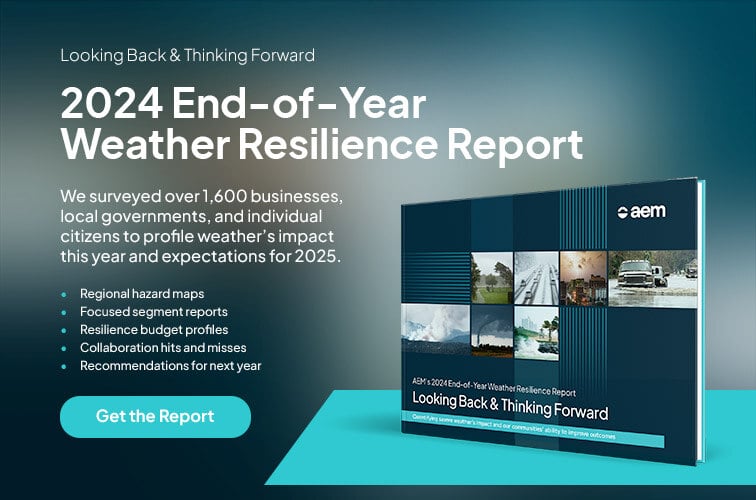
June through August of 2024 was the hottest meteorological summer since the National Oceanic and Atmospheric Administration (NOAA) started keeping records 175 years ago. Last August was the warmest month in recorded history and capped a streak of 15 consecutive months of record high temperatures.
That oppressive heat is only making life harder for those who work outside, like construction teams, public works professionals, agricultural laborers, and athletes, whose work requires exposure to the elements throughout the summer. Protecting those people from heat stress and heat related illnesses is a growing responsibility—one of the greatest of our time.
In order to provide a safe environment for work and play without unnecessary reactionary heat cancellations, businesses, schools, and local governments are increasingly turning to wet bulb globe temperature (WBGT) to inform risk management decisions. Moving forward, we’ll…
- Define WBGT
- Explore why WBGT is a relevant measure of heat stress
- Explain how to calculate WBGT
- Break down how to interpret WBGT readings in a heat safety context
What is wet bulb globe temperature (WBGT)?
Wet bulb globe temperature is a measure of heat stress in direct sunlight. WBGT calculations provide an “apparent temperature” that expresses the amount of heat people are experiencing in a given place based on ambient air temperatures, humidity, wind chill, and the amount of solar radiation present.
While temperature alone only tells you how hot the air is, WBGT provides the true human impact of the weather. In this way, WBGT helps us break through the limitations of the thermometer to truly understand whether it's safe to carry out strenuous activities for a sustained period of time.
WBGT can be expressed in degrees Fahrenheit (as in the U.S.) or Celsius (favored globally).
WBGT vs. wet bulb vs. heat index
Wet bulb globe temperature (WBGT) often gets confused or conflated with several similar concepts. Let’s take a minute to make some key distinctions:
WET BULB TEMPERATURE
Wet bulb temperature (WBT) describes the reading of a bulb-style thermometer exposed to ambient temperatures while covered in a cloth that's been soaked with ambient-temperature water. It’s one of the factors that goes into a wet bulb globe temperature calculation (more on that in a minute), but it doesn’t tell the whole story on its own.
To explain it in the context of heat stress, wet bulb temperatures help us understand the temperature on the skin of an individual who is both exposed to ambient-temperature moisture in the air (humidity) and producing approximately ambient-temperature water (sweating).
HEAT INDEX
One of the biggest misconceptions about WBGT is that it’s the same thing as heat index. While it’s true that both are “apparent temperatures” (meaning they both tell you what the temperature “feels like”), wet bulb globe temperature provides a much fuller picture of conditions.
Heat index is calculated using air temperature and ambient humidity and measured using a dry thermometer, unlike the intentionally damp equipment used to calculate WBT. It is also always calculated using readings from shady areas, which means that the increased stress of direct sunlight is completely missing from the equation.
Since WBGT accounts for the punishing impact of solar radiation as well as wind, it’s a much more accurate and useful measurement of potential heat stress than heat index or WBT individually.
Why is it important to monitor WBGT?
According to the CDC, heat stress is associated with a variety of illnesses including but not limited to:
- Heat stroke: the body’s cooling mechanism fails, leading to internal temperatures of 106 degrees Fahrenheit or greater, potentially causing permanent disability or death
- Heat exhaustion: the body loses too much water and salt to sweating, causing nausea, headache, dizziness, weakness, and beyond
- Rhabdomyolysis: muscle breakdown from over-exertion floods the bloodstream with electrolytes and large proteins, causing weakness and pain
- Heat syncope: dehydration from heat causes dizziness, light-headedness when standing, and fainting
- Heat cramps: dehydration and salt imbalances cause muscle cramps, pain, and spasms throughout the body
- Heat rash: excessive sweating from heat stress creates clusters of tender red pimples or blisters in the neck, armpits, groins, and other areas
In an employment or education scenario, supervisors and administrators are responsible for the health, safety, and physical wellbeing of the workers and students under their supervision. When you combine the legal and moral importance of maintaining a safe environment with rising global temperatures, it’s no wonder everybody is getting interested in WBGT.
Which industries rely most on WBGT calculations?
WBGT is relevant in any scenario where people will be exposed to hot outdoor conditions. With that said, construction, education, and outdoor sports and recreation are the industries where WBGT use is growing most rapidly and people are thinking beyond heat index.
EDUCATION
Whether it’s K-12 or higher education, schools host an incredible variety of outdoor events during the hottest months of the year. Graduation ceremonies, off-season practices, and major facilities improvements are just a few examples of activities that happen on campuses across the country during the months where many people assume school is out of session.
WBGT calculations keep students, student-athletes, and school employees safe by empowering administrators and athletic directors to make smart decisions about when work, practices, and other outdoor activities can be carried out and when it’s necessary to encourage people to stay indoors.
CONSTRUCTION
When you think of strenuous work that’s done outside, construction is probably the first thing that comes to mind. Building structures and roadways involves heavy tools, heavy materials, and heavy protective gear.
At the same time, however, much of that work can only be done “when the sun shines,” creating a perfect storm for heat stress. In the Northeast and Midwest, where snow and ice make construction difficult for half the year, it’s especially crucial to make good use of every available workday during the summer.
All that, coupled with an industry-wide culture of worker safety, has led to rapid adoption of WBGT across construction over the last few years.
SPORTS & RECREATION
Whether it’s a 5k sponsored by the town recreation department, a summer day camp, or even a professional athletic event, any organized activity where somebody could potentially incur one of the heat-related illnesses described above needs to have a heat stress strategy in place to ensure all planned activities are safe.
Different ways to monitor WBGT
As we’ve established, WBGT’s strength as a measurement of heat stress lies is its multifactorial nature. A lot of different data points need to be pulled out, combined, and processed to come up with a wet bulb globe temperature. Here are the most common (and successful) methods
Manual calculations
If you’re the type who likes to do things yourself and has access to a variety of scientific thermometers, then all you need to know is:
WBGT = 0.7Tw + 0.2Tg +0.1Td
Tw = wet bulb temperature (WBT)
Tg = globe thermometer temperature
Td = dry-bulb air temperature
With that said, not many risk management professionals in construction or education have the time to sit around and crunch formulae. It’s the 2020s, so let’s get into some solutions that provide a degree of automation.
Handheld devices
A variety of different handhelds are available on the market to streamline measurement into a single unit and automate calculations. Often, these devices look like a large, bulky television remote control with one or more bulbs extending out of their tops.
These tools provide a major leg up from the pains of manual math, but they still only generate a WBGT rating on demand. Somebody always needs to walk outside into the sunshine, hold the device aloft, and capture the reading manually.
Professional weather stations
In recent years, weather stations have become increasingly affordable, allowing private businesses and schools to access technology that was once reserved for high-level government agencies and research institutions. A station configured with the right sensors can provide all the data necessary to generate a WBGT calculation at any moment.
Using their weather station’s software, any organization can create a dashboard that provides them with real-time wet bulb globe temperatures to inform operational decision-making without any manual data gathering or calculation. In this way, schools, construction businesses, and organizers of athletic events can turn a single weather station into a powerful tool for protecting people and reputations.
How to interpret WBGT thresholds
Admittedly, one of the reasons WBGT wasn’t widely adopted until recently (even though the calculation has been around since the 1950s) is because, unlike heat index, it doesn’t produce striking high numbers that jump off the page and say “DANGER” in big red letters. There’s more subtlety required in understanding how the numbers correlate to risk.
For that reason, part of adopting WBGT as a heat stress prevention solution is creating a plan where specific thresholds are clearly connected to guidance. The entire team must be trained to see beyond whether the number “looks high” and understand how that specific reading should translate into action.
It's also key for all stakeholders to understand which WBGT zone they're in, as that will impact interpretation and guidance. The National Weather Service breaks the Continental United Stations into three categories, as illustrated below:
.jpg?width=400&height=310&name=WBGT%20Zones%20Across%20the%20Continental%20U.S.%20(400%20x%20310%20px).jpg)
Depending on your location, guidance will vary slightly, as the table below illustrates:

Here’s an example of how the Georgia High School Association (in a Category 3 WBGT zone) breaks down WBGT readings into actionable guidance:
| WBGT READING | ACTIVITY & REST BREAK GUIDELINES |
| Under 82.0 | Normal activities - Provide at least three separate rest breaks each hour with a minimum duration of 3 minutes for each break during workout. |
| 82.0 - 86.9 | Use discretion for intense or prolonged exercise; watch at-risk players carefully. Provide at least three separate rest breaks each hour with a minimum duration of 4 minutes each. |
| 87.0 - 89.9 | Maximum practice time is 2 hours. For football: players restricted to helmet, shoulder pads, and shorts during practice. All protective equipment must be removed for conditioning activities. If the WBGT rises to this level during practice, players may continue to work out wearing football pants without changing to shorts. For all sports: provide at least four separate rest breaks each hour with a minimum duration of 4 minutes each |
| 90.0 - 92.0 | Maximum length of practice is 1 hour. For football: no protective equipment may be worn during practice, and there may be no conditioning activities. For all sports: there must be 20 minutes of rest breaks distributed throughout the hour of practice. |
| Over 92.0 | NO OUTDOOR WORKOUTS. Delay practice until a cooler WBGT level is reached. |
Manage heat stress risk with WBGT
With temperatures rising across the country and world, heat stress will continue to grow as a seasonal challenge. Given this year’s record-setting summer, the clock is ticking down on the time businesses, schools, and municipalities have to establish a strategy for next year.
If you’re interested in creating automated WBGT reports that support sound decision-making and a responsible, people-first culture of risk management while still preserving plenty of time for work and play, AEM is here to help. We empower customers to:
- Monitor real-time weather conditions with affordable professional-grade weather stations
- Alert employees, administrators, coaches, students, and beyond to severe weather risks
- Respond to severe weather challenges by leveraging reliable data
To begin your journey toward building a heat stress management solution that works for your team, contact AEM today!




